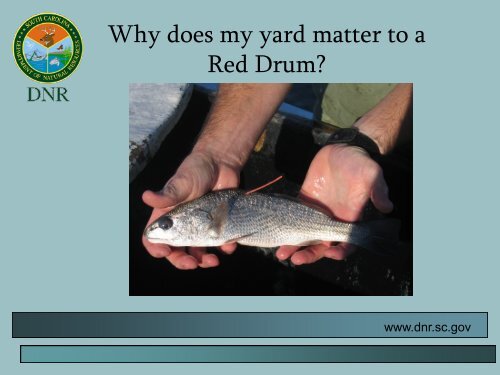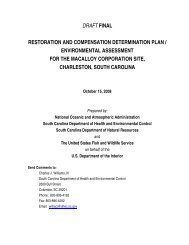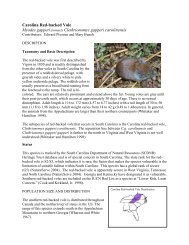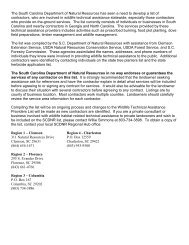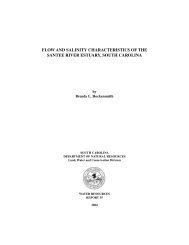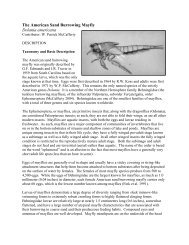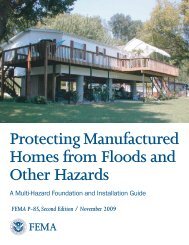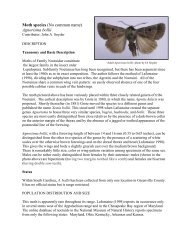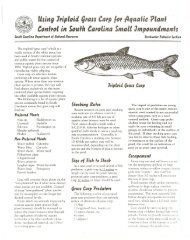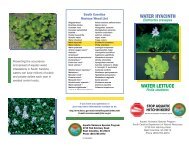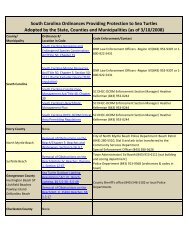view presentation here - SC Department of Natural Resources
view presentation here - SC Department of Natural Resources
view presentation here - SC Department of Natural Resources
You also want an ePaper? Increase the reach of your titles
YUMPU automatically turns print PDFs into web optimized ePapers that Google loves.
Why does my yard matter to a<br />
Red Drum?<br />
www.dnr.sc.gov
Why does DNR care about<br />
development?<br />
• Increased pressure on natural resources:<br />
200 acres <strong>of</strong> natural landscape are lost<br />
every day to development<br />
– Habitats are necessary for healthy water<br />
• Changes to environmental conditions:<br />
South Carolina is 40 th in size in the nation,<br />
but 10 th in the rate <strong>of</strong> land development<br />
– Land development changes environmental<br />
conditions<br />
Conservation Voters <strong>of</strong> <strong>SC</strong>
Land-Use Changes<br />
1994 1999<br />
D. Berquist, <strong>SC</strong>DNR, <strong>SC</strong>ECAP
Impervious Cover<br />
• Roads, ro<strong>of</strong>tops, parking lots, hard<br />
surfaces<br />
• Impede natural pollutant processing<br />
• Alters the rate, volume, and quality<br />
<strong>of</strong> freshwater and sediment inflows
Pervious Cover
What happens when water<br />
quantity and quality changes?<br />
Storm Event – 24 hr, 4.5 in. rainfall<br />
Urban – New Market (~50% impervious cover)<br />
Suburban – James Island (~21% impervious cover)<br />
Forested – North Inlet (~0%)<br />
Anne Blair 2008<br />
NOAA / NCCOS / Hollings Marine Laboratory, Charleston <strong>SC</strong>
What happens when water<br />
quantity and quality changes?<br />
Run<strong>of</strong>f depth (in.)<br />
3<br />
2<br />
Storm Event – 24<br />
hr, 4.5 in. rainfall<br />
2.85<br />
1.12<br />
1<br />
0.64<br />
0<br />
North Inlet James Island New Market<br />
Intertidal Watersheds – South Carolina<br />
Anne Blair 2008<br />
NOAA / NCCOS / Hollings Marine Laboratory
On average, Charleston receives 50 inches <strong>of</strong><br />
rain each year.<br />
Your ro<strong>of</strong> size can be estimated by taking the<br />
square footage <strong>of</strong> one story <strong>of</strong> your home and<br />
garage.<br />
1 inch <strong>of</strong> rainfall on a 1,000 square foot ro<strong>of</strong> =<br />
620 gallons <strong>of</strong> water<br />
50 inches <strong>of</strong> rain per year on a 1,000 square<br />
foot ro<strong>of</strong> =<br />
About 31,000 gallons <strong>of</strong> water coming <strong>of</strong>f<br />
your ro<strong>of</strong> each year.
What happens when water<br />
quantity and quality changes?<br />
1999-2000 2001-2002 2003-2004 2005-2006<br />
D. Berquist, <strong>SC</strong>DNR, <strong>SC</strong>ECAP
What happens when water<br />
quantity and quality changes?
So what can we do?<br />
– Install a rain barrel or cistern<br />
– Build a rain garden<br />
– Plant native landscaping<br />
– Increase tree canopy/protect trees<br />
– Install pervious surfaces<br />
– Scoop your pet’s poop<br />
– Pick up litter<br />
– Minimize fertilizer use<br />
– Compost your yard waste
Capture the Water Instead!
Rain Barrel Installation
Build your own Rain Garden<br />
• Allows collection <strong>of</strong> stormwater and infiltration<br />
• Plants and microbes do the work <strong>of</strong> pollutant removal<br />
• Can be attractor for birds and butterflies
Location, Location, Location<br />
• Intercept the water before it reaches storm drains<br />
• Gutters and downspouts help direct ro<strong>of</strong>top run<strong>of</strong>f flow<br />
• Driveway and sidewalk edges can also make good spots<br />
• Watch how water flows during a storm event
W<strong>here</strong> do we put the rain garden?<br />
• > 10 ft. from building foundation<br />
• > 25 ft. from septic system drainfield<br />
• In full to partial sun, if possible<br />
• Make sure to test the soil for<br />
its ability to drain<br />
1. Dig a hole about 6 inches<br />
deep and wide<br />
2. Fill the hole to the top with<br />
water<br />
3. Check if the water is gone 24<br />
hours later
What size should our rain garden be?<br />
1. Determine the area <strong>of</strong> impervious run<strong>of</strong>f source<br />
(ro<strong>of</strong>tops + sidewalks + driveway areas)<br />
2. Estimate the size <strong>of</strong> your rain garden by making<br />
it 20-40% <strong>of</strong> the impervious area (more for<br />
poorly drained sites)<br />
3. The excavated area should be 6-8” deep<br />
4. The area should be 8-10 ft wide – usually in a<br />
kidney bean shape
Now, what do I put in it?<br />
• Consider the existing soil for<br />
drainage and organic content<br />
• Rain garden soil mix:<br />
- Sand: 50-60%<br />
- Compost: 20-30%<br />
- Top soil: 20-30%<br />
• Plant with native species<br />
• Mulch cover at least 1 in. deep<br />
• Be sure to use pine bark or<br />
similar “non-floating” mulch!!
<strong>Resources</strong><br />
• DNR/ACE Coastal Training Program<br />
http://www.dnr.sc.gov/marine/NERR/traininggarden.html<br />
rain garden manuals and installation information<br />
• Carolina Clear http://www.clemson.edu/public/carolinaclear/<br />
general water resource info and rain garden manual<br />
• Palmetto Rain Barrels - Gary Pierce (704-562-2565)<br />
www.palmettorainbarrels.com<br />
• Lowcountry Rain Barrels - Russ Charek (843-271-6255)<br />
www.LCRainBarrel.com<br />
• Lowcountry Rain Catchers - Bruce Bonge (843-322-3230)<br />
www.lowcountryraincatchers.com<br />
• CloudBurst Water Harvesting – Heath Timmerman (843-388-5360)<br />
www.CloudburstWHG.com<br />
• Clemson Extension - Dave Joyner (843-722-5940 x125)<br />
djoyner@exchange.clemson.edu<br />
how to build your own rain barrel
Land Use Change<br />
• Land use change<br />
– Population increase and<br />
sprawl →<br />
– Dramatic alteration <strong>of</strong><br />
landscape →<br />
– Impact on biodiversity and<br />
ecological processes<br />
• Human influence is<br />
inevitable<br />
• Can society and<br />
ecological integrity be<br />
compatible?<br />
willamettevalleydailyphoto.specialweb.com<br />
www.bne.com.au
• Native: One that originated in the area which it<br />
grows (Porcher and Rayner 2001)<br />
• <strong>Natural</strong>ized: Plants that are thoroughly<br />
established; yet are not native. Have not caused<br />
extensive damage or spread. Are more or less<br />
accepted as native (Porcher and Rayner 2001)<br />
• Exotic: Plants that have been introduced by<br />
human intervention to an area outside their<br />
native habitat (<strong>SC</strong>NPS)<br />
• Invasive: Introduced to an area, established<br />
breeding population, and spread to extent that<br />
damages agriculture or natural species. (<strong>SC</strong>NPS)
How are Invasive Plant Species<br />
Introduced?<br />
• Intentional Function<br />
• Accidental Transport<br />
• Gardening Efforts<br />
www.mdinvasivesp.org
Characteristics <strong>of</strong> Invasive Plants<br />
Species<br />
• Efficient dispersal <strong>of</strong><br />
seeds<br />
• Quick growth that enables<br />
to “crowd out” slower<br />
growing plants<br />
• Early sexual maturity<br />
• Similar climate as native<br />
range; however lack <strong>of</strong><br />
restricting agents<br />
<strong>SC</strong>NPS<br />
<strong>SC</strong>DNR; Marine Turtle<br />
Conservation Project<br />
Carolina’s Beach Vitex<br />
Task Force
images.harc.edu<br />
Why Problematic?<br />
• 2 nd largest threat to native flora<br />
• Crowd out native species<br />
• Reduce biological diversity (and plants that wildlife<br />
depend on)<br />
• Interfere with natural succession<br />
• $35 billion in economic costs
Major Key Species <strong>of</strong> Concern in<br />
the Lowcounty <strong>of</strong> South Carolina<br />
• Japenese Privet Ligustrum japonicum<br />
• Chinese Privet<br />
• Multiflora Rosa<br />
Ligustrum sinensis<br />
Rosa multiflora<br />
• Japanese Honeysuckle Lonicera japonica<br />
• Kudzu<br />
• Chinese Wisteria<br />
• Chinese Tallow<br />
• Beach Vitex<br />
Pueraria lobata<br />
Wisteria sinensis<br />
Triadica sebifera<br />
Vitex rotundifolia
Unless otherwise specified, photos courtesy <strong>of</strong> “invasive plant pest species guide <strong>of</strong> <strong>SC</strong>”<br />
~South Carolina Exotic Pest Plants Council<br />
The Usual Suspects<br />
Wisteria<br />
Kudzu<br />
www.thetandd.com<br />
Japanese Honeysuckle<br />
Chinese Privet<br />
English Ivy<br />
www.calflora.net<br />
Autumn Olive<br />
www.emitsburg.net
Chinese<br />
Tallow<br />
Photos by K. Counts
What can you do?<br />
Go Native!
Going Native Includes Benefits:<br />
• Sense <strong>of</strong> Place<br />
• Wildlife<br />
• Less Maintenance<br />
• Good for the Environment<br />
K. Counts<br />
Otter Island, <strong>SC</strong><br />
Photos courtesy B. McCord
Combat Climate Change<br />
• Plant Native<br />
• Reduce Water Use<br />
• Mulching<br />
• Compost<br />
• Green Ro<strong>of</strong><br />
• Less Lawn<br />
• Non-gasoline lawn eq.<br />
• Compact fluorescents, timers, solarpowered<br />
lights<br />
~National Wildlife Federation
Dogwood<br />
Small Trees<br />
Redbud<br />
Bald Cypress<br />
www.kenedyscountygardnes.org<br />
Red Maple<br />
Southern Sugar Maple<br />
www.cornerstonetreefarm.com<br />
American Holly<br />
Serviceberry<br />
www.colorodotrees.org<br />
www.missouristate.edu<br />
www.huntersville.org
Shrubs<br />
Yaupon Holly<br />
www.forestryimages.org<br />
Beauty Berry<br />
Drawf Palmetto<br />
Wax myrtle<br />
www.cornerstonetreefarm.com
Vines/ Ground Covers<br />
www.birds_n_garden.com<br />
Coral Honeysuckle<br />
www.netstate.com<br />
Yellow Jessamine<br />
American Wisteria<br />
www.growwildnursery.com<br />
www.ces.ncsu.edu<br />
Crossvine
Perennials<br />
Sweetgrass<br />
Atamasco Lilly<br />
www.bustaniplantfarm.org<br />
Coral Bean<br />
Blue Flag Iris<br />
Butterfly weed<br />
www.mo.gov<br />
www.nativeorchird.org
What else can I do to be a steward in my<br />
yard?<br />
Host Larval Plants<br />
Wild birds Unlimited website
• South Carolina Native Plant Society<br />
www.scnps.org<br />
<strong>Resources</strong><br />
• South Carolina Exotic Pest Plant Council<br />
http://www.se-eppc.org/southcarolina<br />
• National Wildlife Federation<br />
www.nwf.org<br />
• Clemson Extension Home and Garden<br />
Information Center<br />
1-888-656-9988<br />
www.clemson.edu/public<br />
• A Guide to the Wildflowers <strong>of</strong> South Carolina<br />
By: Richard D. Porcher and Doughlas A. Rayner.<br />
Published in 2001.<br />
• Local Nurseries
Thank You!<br />
Photo by: K. Counts
Coastal Exploration Series<br />
• Kim Counts 843-953-9354
Coastal Training Program<br />
• Rebekah Szivak 843-953-9024


